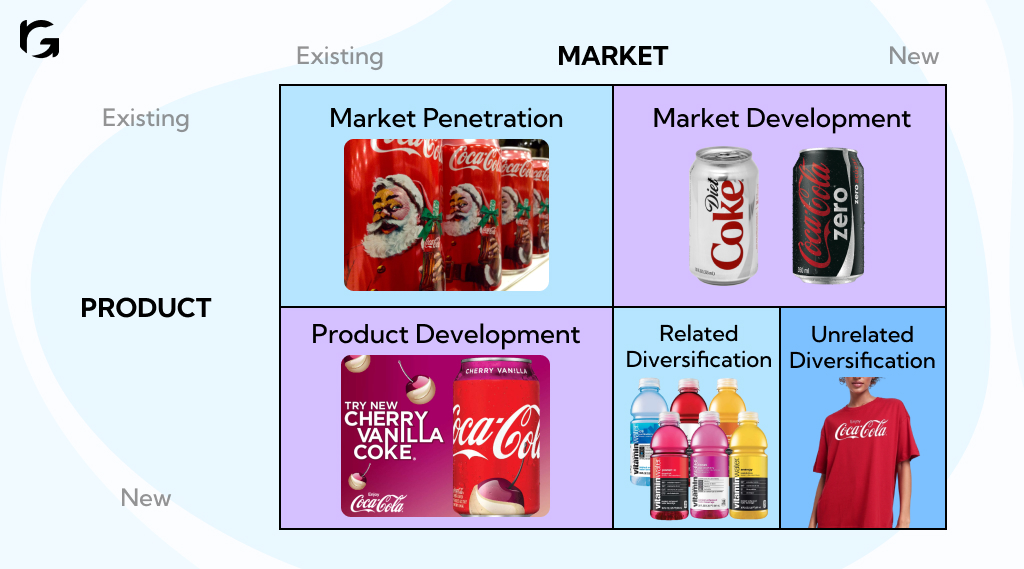Introduction
“What separates good content from great content is a willingness to take risks and push the envelope.” — Brian Halligan, CEO & Co-founder, Hubspot.
Have you ever felt your product has reached its maximum potential in your current market? This is a familiar feeling for businesses of all sizes, and it’s a signal that it might be time to consider product market expansion.
To make the most of the Product Market Expansion Grid, it’s important to understand your company’s current position, the amount of resources you can expend, and how much risk your company can carry. Once you have identified your position on the grid, your internal capabilities, and how much risk you can take on, the next step is conducting market research.
In this blog, we will discuss in detail what a Saas product marketing expansion grid is and how you can create one for your business. So, let’s dive in!
What is a product-market expansion grid?

The product-market expansion grid, also known as the Ansoff Matrix, is a strategic planning tool used by businesses to develop growth strategies. It examines the relationship between new and existing products, new and existing markets, and the risk associated with each possible relationship.
It was developed by Igor Ansoff in the 1950s and published by Harvard Business Review.
The matrix is designed so that as a company plots its new and existing products and markets, the risk associated with that strategy corresponds with its position on the grid. Developing a strategy with existing products and markets is low risk, but risk increases with new products and markets
The grid consists of four growth strategies, each representing a combination of existing and new products and existing and new markets:
- Market penetration
- Market development
- Product development
- Diversification
1. Market penetration:
It is selling more of the existing products to existing markets. Companies achieve this by increasing market share, improving product quality, adjusting pricing strategies, or intensifying marketing efforts.
To enter new distribution channels, you can run advertising campaigns and loyalty programs. The goal is to attract customers from competitors or encourage existing customers to buy more.
2. Market development:
It is the introduction of existing products to new markets. This could mean entering new geographic regions, targeting different demographic segments, or tapping into unexplored distribution channels.
Companies may need to invest in marketing campaigns to raise awareness. Market development helps companies to expand their customer base and reduce dependency on existing markets.
3. Product development:
It helps in development of new products or services to cater to existing markets. Companies innovate by introducing new features, improving functionality, or creating entirely new product lines.
Product development requires substantial research and development (R&D) investments to ensure that the new offerings meet customer needs and align with market trends.
The objective is to capitalize on existing customer relationships and market knowledge to introduce products that offer additional value or address emerging needs.
4. Diversification:
Diversification involves entering entirely new markets with new products. This can be the riskiest strategy as it entails venturing into unfamiliar territory.
Diversification can provide opportunities for growth and reduce vulnerability to market fluctuations in specific industries. However, it requires careful planning and execution to mitigate risks effectively.
The product-market expansion grid offers a structured approach for companies to evaluate growth and choose the most suitable strategies based on their capabilities, resources, and market conditions. Businesses can make informed decisions to drive sustainable growth by systematically analyzing their options.
Expanding the business into new products and markets, reducing the risk of dependence on a single product or market, or achieving growth through new opportunities in new markets.
To make the most of the Product Market Expansion Grid, you’ll need to understand where your best opportunities are given your current position, the amount of resources you can expend, and how much risk your company can carry. While the grid is useful for understanding how to think of business growth options, it stops short of explaining what actions you should take.
Once you have identified your position on the grid, your internal capabilities, and how much risk you can take on, the next stop is conducting market research. Applying proper market research will transform this from a theory to information you can act on.
How do you create a product marketing expansion grid?
Creating a market-product grid, also known as a product-market expansion grid or Ansoff Matrix, is a strategic process that requires careful analysis and planning. Here are the steps to create one:
- Identify your products/services
- Identify your target markets
- Develop action plans
1. Identify your products/services
Begin by listing all the products or services your business currently offers. This could include existing market share and potential new ones you’re considering for your customer needs.
2. Identify your target markets
Next, identify the target market or customer segments that your business serves or intends to serve. Considergeography, demographics, industry, or specific needs and preferences.
Learn how you can do market research for your target market.
3. Develop action plans
Different strategies develop detailed action plans, including marketing, sales, R&D, and operational strategy. Define key performance indicators (KPIs) to measure success.
Creating a market-product grid is a dynamic process that helps businesses align their products with existing products, ultimately driving growth strategy. It serves as a roadmap for strategic decision-making and resource allocation.
Product market expansion grid example

Let’s explore how some of the world’s leading companies, including Coca- Cola might apply the Product-Market Expansion Grid strategies:
Coca-Cola:
1. Market penetration:
Coca – Cola might focus on increasing sales of its existing beverage products by intensifying marketing efforts, expanding distribution channels, or adjusting pricing strategies to gain market share from competitors.
2. Market development:
They could expand into new geographic markets by introducing their existing brands to regions where they are not yet dominant. For example, they might target emerging markets in Africa or Latin America with their carbonated soft drinks or bottled water products.
3. Product development:
They continuously innovate to meet changing consumer preferences and health trends. It might develop new formulations, flavors, or packaging formats for its existing brands, such as introducing sugar-free or natural sweetener options for its sodas.
4. Diversification:
They could diversify into adjacent product categories or industries. For instance, it might enter the energy drinks market by acquiring or launching brands offering caffeinated beverages or functional drinks targeting specific consumer segments.
Conclusion
The Product-Market Expansion Grid is a versatile and indispensable tool for businesses seeking growth and diversification strategies. This framework by Igor Ansoff, provides an easy approach to build business in the context of b2b or b2c.
B2C companies like Coca Cola have applied these strategies and expanded their market with high profits.
If you are also planning to make a strategy for your business and confused on how to get started? Well, no worries! Revv Growth will help you in building a highly profitable product marketing strategy.
Talk to us and we will together take your SaaS business to the next level. Contact us now!
FAQ’s
1. What is the product market expansion grid in marketing?
Product market expansion grid, is a tool used to analyze the risk involved in each potential interaction between new and existing products, markets, and products in order to establish corporate expansion strategies.
2. What are the four squares of the product market expansion grid?
- Market penetration: Selling more of your existing product to your current customers (think: running promotions or loyalty programs).
- Market development: Selling your existing product to new customers (think: entering a new country or targeting a different age group).
- Product development: Creating a new product for your current customers (think: adding a new flavor to your existing line of snacks).
- Diversification: Creating a completely new product for a totally new market (think: a coffee company launching a fitness tracker).
3. What is the other name for product market expansion grid?
Product market expansion grid is also known as Ansoff Matrix. It’s named after Igor Ansoff, the economist who developed this framework in the 1950s to help businesses plan their growth strategies.



